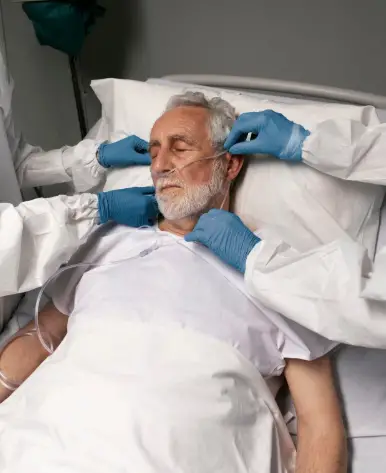Understanding End-of-Life Olfactory Changes: A Medical Professional’s Perspective on Terminal Care Indicators
Introduction: The Science Behind Human Scent and Mortality
The human body represents a complex biological system that continues to reveal mysteries despite centuries of medical advancement and scientific research. Among the lesser-understood phenomena in healthcare is the distinctive olfactory changes that occur during the end-of-life process, a topic that has gained attention from medical professionals working in palliative care, hospice settings, and terminal patient management.
These scent changes, while not widely discussed in popular medical literature, represent important clinical indicators that experienced healthcare professionals have observed and documented throughout their careers. Understanding these phenomena provides valuable insights for medical staff, caregivers, and family members who may encounter these situations during end-of-life care provision.
The study of end-of-life olfactory changes intersects multiple medical disciplines, including biochemistry, physiology, and thanatology, creating a comprehensive understanding of how the human body undergoes systematic changes as biological functions begin to cease. This analysis examines the scientific basis for these observations while providing professional context for healthcare workers and educated consumers seeking to understand this aspect of human biology.
The Biochemistry of Human Scent Production
Human body odor results from complex interactions between bacterial populations, metabolic processes, and environmental factors that create unique olfactory signatures for each individual. Under normal physiological conditions, the body maintains a delicate balance of chemical compounds, bacterial colonies, and metabolic byproducts that contribute to baseline scent characteristics.
The skin microbiome plays a crucial role in scent production through bacterial metabolism of sebaceous secretions, dead skin cells, and other organic compounds present on the skin surface. These bacterial processes produce various volatile organic compounds (VOCs) that contribute to individual scent profiles, influenced by factors including diet, hygiene practices, genetic predisposition, and overall health status.
During terminal illness and end-of-life processes, significant physiological changes alter these normal scent-producing mechanisms. Metabolic dysfunction, organ failure, and cellular breakdown create new chemical compounds while disrupting normal bacterial balance and waste elimination processes, resulting in distinctive olfactory changes that experienced healthcare professionals can recognize.
Clinical Observations from Healthcare Professionals
Julie McFadden, a registered nurse with extensive experience in terminal care at healthcare facilities in Los Angeles, has documented specific olfactory phenomena observed in patients approaching end-of-life. Her professional observations, shared with medical media outlets, provide valuable insights into the practical aspects of recognizing and understanding these changes within clinical settings.
According to McFadden’s clinical experience, patients in terminal stages often emit distinctive odors that differ significantly from normal body scent variations. These changes typically occur in conjunction with other physiological indicators of approaching death, providing healthcare workers with additional assessment tools for patient monitoring and family preparation.
The nursing profession’s unique position in direct patient care enables frontline observation of these phenomena, as nurses spend extended periods in close proximity to patients during various stages of terminal illness. This proximity provides opportunities for detailed observation and documentation of scent changes that may not be apparent during brief physician examinations.
Professional healthcare workers in hospice and palliative care settings often develop heightened sensitivity to these olfactory changes through repeated exposure and clinical experience, enabling earlier recognition of end-of-life progression and more accurate family counseling regarding expected timeframes and care needs.
The Role of Putrescine and Cadaverine in End-of-Life Odor
The distinctive odors associated with end-of-life processes primarily result from the production of specific chemical compounds, particularly putrescine and cadaverine, which are biogenic amines produced through bacterial decomposition of amino acids within the body. These compounds represent early indicators of cellular breakdown and metabolic failure that characterize the dying process.
Putrescine, chemically known as 1,4-diaminobutane, results from bacterial decarboxylation of ornithine and arginine amino acids. This compound produces a distinctive, unpleasant odor often described as reminiscent of rotting flesh or decay. The presence of putrescine in living patients indicates that cellular breakdown processes have begun, even while other vital functions continue.
Cadaverine, or 1,5-diaminopentane, forms through bacterial decarboxylation of lysine amino acids and contributes to the characteristic odor of decomposing organic matter. Like putrescine, cadaverine production in living patients suggests significant metabolic dysfunction and cellular damage that precedes clinical death.
The production of these compounds occurs when normal cellular maintenance processes fail to prevent bacterial overgrowth and when metabolic pathways become disrupted due to organ failure, circulation problems, or immune system dysfunction. Understanding these biochemical processes helps healthcare professionals recognize and explain these phenomena to concerned family members.
Metabolic Changes and Secondary Olfactory Indicators
Beyond the primary compounds associated with cellular breakdown, terminal patients often experience metabolic changes that produce additional distinctive odors through various physiological mechanisms. These secondary indicators provide healthcare professionals with comprehensive assessment tools for monitoring disease progression and patient comfort.
Ketosis, resulting from altered carbohydrate metabolism during terminal illness, produces distinctive breath odors often compared to nail polish remover or acetone. This metabolic state occurs when the body begins breaking down fat stores for energy due to decreased food intake, digestive dysfunction, or metabolic disruption associated with terminal illness.
Liver dysfunction during end-of-life processes can produce distinctive odors through impaired detoxification processes and accumulation of metabolic waste products. These changes may manifest as breath odor, skin scent variations, or altered body fluid composition that creates noticeable olfactory changes.
Kidney failure contributes to distinctive odor changes through uremic toxin accumulation and altered fluid balance. These changes affect breath, skin, and bodily fluid composition, creating additional olfactory indicators that experienced healthcare professionals can recognize and interpret.
Disease-Specific Olfactory Manifestations
Different terminal illnesses produce characteristic odor profiles that reflect the specific organ systems and metabolic processes affected by each condition. Understanding these disease-specific patterns enables more accurate assessment and family education regarding expected changes during end-of-life care.
Gastrointestinal cancers, particularly those affecting the stomach, liver, or bowel, often produce especially pronounced odor changes due to digestive system dysfunction, bacterial overgrowth, and metabolic disruption within the digestive tract. These conditions may create particularly challenging situations for family caregivers who require professional support and education.
Respiratory conditions affecting terminal patients can produce distinctive breath odors through altered lung function, bacterial colonization, and impaired gas exchange processes. These changes often accompany other respiratory symptoms that characterize end-of-life breathing patterns.
Neurological conditions may indirectly affect scent production through altered personal care capabilities, swallowing dysfunction, and metabolic changes associated with decreased mobility and nutrition. These secondary effects create complex olfactory profiles that require professional assessment and management.
The Death Rattle: Auditory Indicators Accompanying Olfactory Changes
In addition to distinctive odor changes, terminal patients often develop auditory symptoms known professionally as “death rattle,” which frequently accompany the olfactory phenomena described by healthcare professionals. This crackling, wet breathing sound results from fluid accumulation in the throat and airways when patients lose the ability to swallow or clear secretions effectively.
The death rattle occurs due to weakened respiratory muscles, decreased consciousness levels, and accumulation of saliva, mucus, or other fluids in the upper respiratory tract. While this sound can be distressing for family members, it typically does not cause discomfort for patients who are often unconscious or heavily sedated during this stage.
Understanding the relationship between auditory and olfactory end-of-life changes helps healthcare professionals provide comprehensive family education and support during difficult periods. These phenomena often occur together and represent normal aspects of the dying process rather than medical emergencies requiring intervention.
Professional Implications for Healthcare Workers
Recognition of end-of-life olfactory changes provides healthcare professionals with valuable assessment tools for patient monitoring, family counseling, and care planning. These observations enable more accurate prognostic discussions and help families prepare emotionally and practically for impending loss.
Documentation of olfactory changes in medical records contributes to comprehensive patient assessment while providing valuable information for care team communication and family updates. Standardized observation protocols can improve consistency in recognizing and reporting these phenomena across different healthcare settings.
Professional development and training programs for healthcare workers should include education about end-of-life olfactory changes to improve clinical competency and reduce anxiety among staff members who may encounter these situations. Understanding the scientific basis for these phenomena helps healthcare workers provide accurate information and emotional support to families.
Family Education and Support Considerations
Healthcare professionals play crucial roles in educating families about expected changes during end-of-life processes, including olfactory phenomena that may cause concern or distress. Proactive education helps families understand these changes as normal aspects of the dying process rather than indicators of inadequate care or preventable problems.
Communication strategies should emphasize the natural, biological basis for these changes while providing practical advice for managing any discomfort or concerns that arise. Families benefit from understanding that these phenomena reflect the body’s natural transition process rather than suffering or medical complications.
Support resources, including counseling services, support groups, and educational materials, help families cope with the emotional challenges of witnessing these end-of-life changes. Professional guidance enables families to focus on meaningful connections and comfort measures rather than anxiety about natural biological processes.
Research Opportunities and Future Directions
The study of end-of-life olfactory changes represents an emerging area of medical research with potential applications in palliative care, prognostic assessment, and family support services. Systematic documentation and analysis of these phenomena could improve understanding of dying processes while enhancing care quality.
Advanced analytical techniques, including gas chromatography and mass spectrometry, could provide detailed chemical analysis of end-of-life odor compounds, enabling more precise understanding of underlying biochemical processes. This research could lead to improved prognostic tools and enhanced family education resources.
Interdisciplinary collaboration between healthcare professionals, biochemists, and thanatology researchers could advance understanding of these phenomena while developing evidence-based protocols for assessment and family support. Such research would benefit from input from experienced hospice and palliative care professionals who have observed these changes extensively.
Conclusion: Integrating Scientific Understanding with Compassionate Care
The olfactory changes associated with end-of-life processes represent natural biological phenomena that reflect the complex biochemical transitions occurring as the body approaches death. Understanding these changes from scientific and clinical perspectives enables healthcare professionals to provide better patient care while supporting families through difficult experiences.
Recognition of these phenomena as normal aspects of the dying process, rather than medical complications or care failures, helps reduce anxiety and promote acceptance among families and healthcare workers. Professional education about these topics enhances clinical competency while improving the quality of end-of-life care provision.
The integration of scientific understanding with compassionate care practices creates optimal conditions for supporting patients and families during terminal illness. By acknowledging and explaining these natural biological processes, healthcare professionals can focus attention on comfort measures, emotional support, and meaningful connections that enhance the quality of end-of-life experiences.
As medical understanding of these phenomena continues to evolve through research and clinical observation, healthcare professionals will be better equipped to provide comprehensive, evidence-based care that addresses both the physical and emotional aspects of end-of-life transitions. This knowledge ultimately serves to improve the quality and dignity of care provided during life’s final stages.

Ethan Blake is a skilled Creative Content Specialist with a talent for crafting engaging and thought-provoking narratives. With a strong background in storytelling and digital content creation, Ethan brings a unique perspective to his role at TheArchivists, where he curates and produces captivating content for a global audience.
Ethan holds a degree in Communications from Zurich University, where he developed his expertise in storytelling, media strategy, and audience engagement. Known for his ability to blend creativity with analytical precision, he excels at creating content that not only entertains but also connects deeply with readers.
At TheArchivists, Ethan specializes in uncovering compelling stories that reflect a wide range of human experiences. His work is celebrated for its authenticity, creativity, and ability to spark meaningful conversations, earning him recognition among peers and readers alike.
Passionate about the art of storytelling, Ethan enjoys exploring themes of culture, history, and personal growth, aiming to inspire and inform with every piece he creates. Dedicated to making a lasting impact, Ethan continues to push boundaries in the ever-evolving world of digital content.
